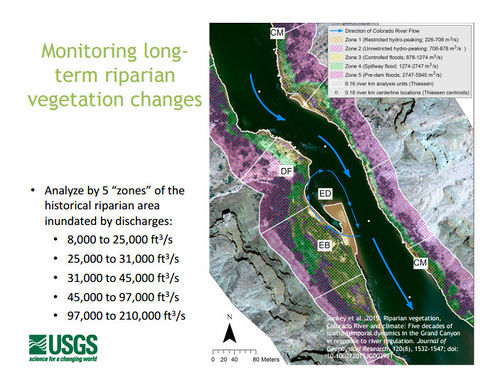Difference between revisions of "ECOSYSTEM"
Cellsworth (Talk | contribs) |
Cellsworth (Talk | contribs) |
||
| (14 intermediate revisions by the same user not shown) | |||
| Line 1: | Line 1: | ||
| − | + | ||
__NOTOC__ __NOEDITSECTION__ | __NOTOC__ __NOEDITSECTION__ | ||
<!-- | <!-- | ||
| Line 12: | Line 12: | ||
<tr style='mso-yfti-irow:0;mso-yfti-firstrow:yes'> | <tr style='mso-yfti-irow:0;mso-yfti-firstrow:yes'> | ||
<td width=40% valign=bottom align=left style='width:2.05in;padding:0in 5.4pt 0in 5.4pt'> | <td width=40% valign=bottom align=left style='width:2.05in;padding:0in 5.4pt 0in 5.4pt'> | ||
| − | <p class=MsoNormal> | + | <p class=MsoNormal></p> |
</td> | </td> | ||
</tr> | </tr> | ||
</table> | </table> | ||
| + | |||
| + | [[Image:VegetationMonitoring.jpg|500px|center]] | ||
<!-- | <!-- | ||
| Line 22: | Line 24: | ||
|style="width:60%; font-size:120%;"| | |style="width:60%; font-size:120%;"| | ||
| − | ==''' | + | ==[http://gcdamp.com/index.php?title=Long-term_Experimental_and_Management_Plan_(LTEMP) '''LTEMP Resource Goal for Natural Processes'''] == |
| + | Restore, to the extent practicable, ecological patterns and | ||
| + | processes within their range of natural variability, including the natural | ||
| + | abundance, diversity, and genetic and ecological integrity of the plant and | ||
| + | animal species native to those ecosystems. | ||
| − | + | ==[http://gcdamp.com/index.php?title=Portal:Desired_Future_Conditions_-DFCs '''Desired Future Condition for Native Species and Biotic Communities''']== | |
| − | + | ||
| − | + | ||
| − | + | ||
| − | + | ||
| − | + | ||
| − | = | + | |
| − | + | ||
| − | + | ||
| − | + | ||
| − | + | ||
'''Nonfish Biotic Communities:'''<br> | '''Nonfish Biotic Communities:'''<br> | ||
| Line 67: | Line 63: | ||
|- | |- | ||
|style="color:#000;"| | |style="color:#000;"| | ||
| − | |||
| − | |||
| − | |||
| − | |||
| − | |||
| − | |||
| − | |||
| − | |||
| − | |||
| − | |||
|} | |} | ||
| Line 85: | Line 71: | ||
|class="MainPageBG" style="width:45%; border:1px solid #cedff2; background:#f5faff; vertical-align:top;"| | |class="MainPageBG" style="width:45%; border:1px solid #cedff2; background:#f5faff; vertical-align:top;"| | ||
{| width="100%" cellpadding="2" cellspacing="5" style="vertical-align:top; background:#f5faff;" | {| width="100%" cellpadding="2" cellspacing="5" style="vertical-align:top; background:#f5faff;" | ||
| − | ! <h2 style="margin:0; background:#cedff2; font-size:120%; font-weight:bold; border:1px solid #a3b0bf; text-align:left; color:#000; padding:0.2em 0.4em;">Reports and | + | ! <h2 style="margin:0; background:#cedff2; font-size:120%; font-weight:bold; border:1px solid #a3b0bf; text-align:left; color:#000; padding:0.2em 0.4em;">Links and Information</h2> |
| + | |- | ||
| + | |style="color:#000;"| | ||
| + | |||
| + | *[http://gcdamp.com/index.php?title=Portal:GCDAMP_Knowlege_Assessments GCMRC Annual Reports page] | ||
| + | *[http://gcdamp.com/index.php?title=EXTIRPATED Species of Management Concern Page] | ||
| + | *[http://gcdamp.com/index.php?title=Riparian_Vegetation Riparian Vegetation Page] | ||
| + | *[http://gcdamp.com/index.php?title=Nutrients Nutrients Page] | ||
| + | *[http://gcdamp.com/index.php?title=Related_Programs Related Programs] | ||
| + | |||
| + | |- | ||
| + | ! <h2 style="margin:0; background:#cedff2; font-size:120%; font-weight:bold; border:1px solid #a3b0bf; text-align:left; color:#000; padding:0.2em 0.4em;">Papers and Presentations</h2> | ||
|- | |- | ||
|style="color:#000;"| | |style="color:#000;"| | ||
'''2016''' | '''2016''' | ||
| − | *[ | + | *[https://www.usbr.gov/uc/progact/amp/twg/2016-10-18-twg-meeting/Attach_04.pdf Linkages Between Lake Powell Reservoir and the Colorado River Below Glen Canyon Dam] |
| − | + | *[https://www.usbr.gov/uc/progact/amp/twg/2016-02-26-twg-meeting/AR10_Stevens.pdf The Biogeographic Significance of a Large, Deep Canyon: Grand Canyon, Southwestern USA] | |
| − | *[ | + | *[https://www.usbr.gov/uc/progact/amp/twg/2016-02-26-twg-meeting/AR11_Anderson.pdf Ecosystem Monitoring in Glen Canyon National Recreation Area] |
| − | + | ||
| − | + | ||
| − | + | ||
| − | + | ||
| − | *[ | + | |
'''2015''' | '''2015''' | ||
| − | *[ | + | *[https://www.usbr.gov/uc/progact/amp/amwg/2015-02-25-amwg-meeting/Attach_12.pdf The Stakeholder's Perspective - The National Parks Conservation Association] |
| − | *[ | + | *[https://www.usbr.gov/uc/progact/amp/amwg/2015-02-25-amwg-meeting/Attach_11.pdf Lower Colorado River Multi-Species Conservation Program Update] |
| − | + | ||
*[[Media:USGS State of the CR ecosystem in the Grand Canyon- c1282.PDF | USGS State of the Colorado River Ecosystem in the Grand Canyon- c1282]] | *[[Media:USGS State of the CR ecosystem in the Grand Canyon- c1282.PDF | USGS State of the Colorado River Ecosystem in the Grand Canyon- c1282]] | ||
'''2014''' | '''2014''' | ||
| − | *[ | + | *[https://www.usbr.gov/uc/progact/amp/twg/2014-10-28-twg-meeting/Attach_04.pdf Report on Ten Years of Implementing the Lower Colorado Multi-Species Conservation Program (MSCP)] |
'''2012''' | '''2012''' | ||
| − | *According to the ''Basin Study'' (2012)] results suggested that '''ecological''' and recreational metrics were amongst the most vulnerable to future conditions...[Source: 2.4;Figure 2.3]*[http://www.usbr.gov/lc/region/programs/crbstudy/finalreport/Executive%20Summary/Executive_Summary_FINAL_Dec2012.pdf| LINK] | + | *According to the ''Basin Study'' (2012)] results suggested that '''ecological''' and recreational metrics were amongst the most vulnerable to future conditions...[Source: 2.4;Figure 2.3] |
| + | *[http://www.usbr.gov/lc/region/programs/crbstudy/finalreport/Executive%20Summary/Executive_Summary_FINAL_Dec2012.pdf| LINK] | ||
| + | '''2010''' | ||
| + | *[https://www.usbr.gov/uc/progact/amp/twg/2010-11-15-twg-meeting/Attach_11c.pdf Preliminary Update to TWG on Second Ecosystem Modeling Workshop] | ||
|- | |- | ||
| Line 117: | Line 111: | ||
|style="color:#000;"| | |style="color:#000;"| | ||
| − | + | ||
<br> | <br> | ||
|} | |} | ||
Latest revision as of 16:06, 21 January 2022
|
|
LTEMP Resource Goal for Natural ProcessesRestore, to the extent practicable, ecological patterns and processes within their range of natural variability, including the natural abundance, diversity, and genetic and ecological integrity of the plant and animal species native to those ecosystems. Desired Future Condition for Native Species and Biotic CommunitiesNonfish Biotic Communities: CRE Riparian Domain: |
| --- |
--- |
--- |
|---|
|
|
